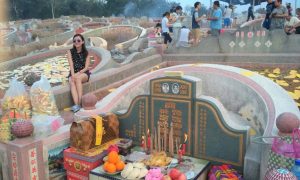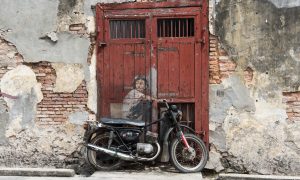I’ve come to talk to Carol SelvaRajah about her recently released food memoir, Dining with Dragons. SelvaRajah grew up surrounded by Nyonya cooking at her childhood home in Klang, Malaysia, and is an expert in this unique and elaborate cuisine. As I approach her home, a fragrant nutty smell beckons me inside and up the stairs. When she opens the door my nostrils are filled with the alluring aromas of creamy coconut milk mixed with a variety of spices such as cinnamon, cloves, turmeric, chilli, coriander and cumin, exciting not just hunger, but also my imagination. The dish she is preparing, Inche Kabin (double-fried crispy chicken) is a Penang favourite and a typical Nyonya taste experience.

Carol SelvaRajah’s Inche Kabin. Photo: S. Rogers
Inche Kabin is one of 28 personal heirloom recipes included in SelvaRajah’s book and one of the dishes she made this year to celebrate the Year of the Rooster. Dining with Dragons is more than a personal memoir of her fascinating life as a celebrity chef and cookery book author. SelvaRajah is also a food historian, and one of the themes of her book is the power of food, particularly Nyonya cuisine, to both reflect and act as an agent of social change.
Nyonya is the unique cuisine developed by the Peranakan communities in the Straits Settlements of Malacca (Melaka), Penang and Singapore. These communities – typically understood as consisting of locally born Chinese, but also including a much smaller community of locally born Indians – developed as a result of increasing mobility and intermarriage. They are often described as ‘hybrid’ or ‘fusion’, because the Baba (male peranakan) and Nyonya (female peranakan) maintained their ancestor’s traditions while also adopting much of the local culture.
‘To study this fusion,’ says SelvaRajah, ‘we need to go directly to Malacca, where Nyonya cuisine originated.’ Located on the west coast of peninsula Malaysia, the port city of Malacca was an important trading hub for spices, porcelain and other valuable goods. It was also a place to exchange ideas, beliefs and knowledge.
As Nor-Afidah Abdul Rahman says,
Malacca’s rise was meteoric, bringing the Malays once again to the forefront of international trade. Acting as a prime redistribution centre of the fabled spice trade – cloves, nutmeg and mace – its fame spread to China, the Indian Ocean and the Mediterranean.
Malacca’s status was further enhanced in the early 15th century by the visit of Chinese envoys. These visits led to Malacca being given the right to participate in the Ming Chinese tributary trade, a status that then attracted international traders.
Malacca was given more than just access to the imperial Chinese market. The Ming emperor, realising the importance of forming an alliance, offered not only trading rights and protection from pesky pirates, but also one of his daughters, Princess Hang Li Poh, to marry the Malaccan Sultan. This auspicious event built upon already-strong trade networks from China, and contributed to the fusion of cultures that eventually became known as Baba Nyonya.
Malacca was also home to wealthy Muslim merchants from Gujarat (India), whose religious beliefs further influenced the development of food traditions – and the introduction of new ingredients – in the region.
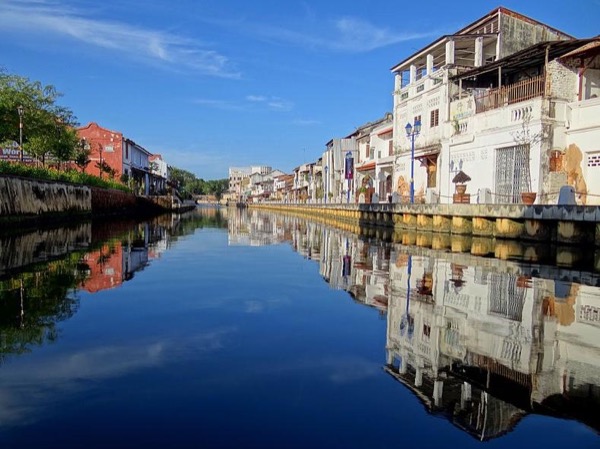
With its government buildings, churches, squares and fortifications, UNESCO World Heritage-listed Malacca demonstrates a history of exchange and trade originating in the 15th-century Malay sultanate and the Portuguese and Dutch periods beginning in the early 16th century. Photo: UNESCO
According to SelvaRajah, a commonly accepted view of Nyonya cuisine is that it is a composite of the ‘parent’ cuisines of India and China. ‘Indian cuisine was reliant on dairy foods, coconut and spices, while Chinese food was founded on the tofu culture.’ she says. Typical ingredients include curry leaves, coconut, ginger, onions, garlic and tamarind from India, and tofu, noodles, spring onions, ginger, soy and oyster sauces from China. Food preparation techniques were also key, in particular wok frying from China.
But Nyonya cuisine is more than simply the offspring of an Indian and Chinese marriage. It is important to remember that there were also local ingredients and influences at play in the development of these cuisines. As Nyonya cuisine developed, cooks incorporated innovative food preparation techniques as well as local ingredients: fruits, lemongrass, galangal, pandan (screwpine leaves), kaffir lime leaves and assam gelugor (sour fruit) from Malaya; and cloves, mace, nutmeg, pepper, cinnamon bark, cardamom seeds, tapeh (fermented cassava), tempeh and buak keluak (black chestnuts) from Indonesia.
Nyonya can also be distinguished by what is left out. As SelvaRajah explains, fish sauce is rarely used; instead, flavour is added with chilli oil, oyster sauce and of course belacan, a pungent fermented shrimp paste found throughout equatorial Southeast Asia. The capability of a cook could be determined based on the tempo with which she (and it was always a she) crushed the spices to prepare the belacan.
Other ingredients, such as chillies and yam beans from South America, testify to the spread of early trade networks. And when the Portuguese captured Malacca in 1511, their preferences, ingredients and food preparation techniques was also incorporated into the mix, demonstrating the remarkable resilience and adaptability of this cuisine.
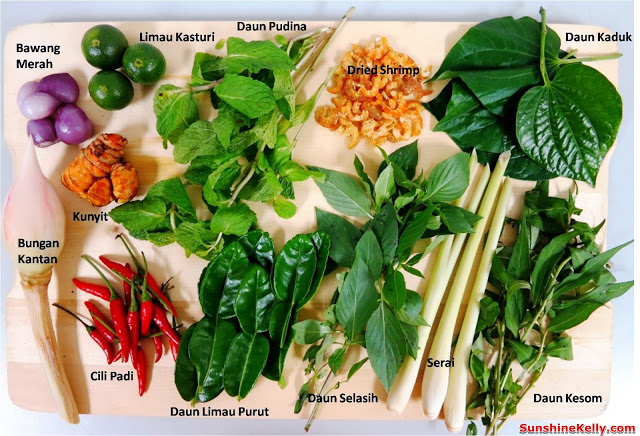

Some of Nyonya cuisine’s key ingredients. Photo: S. Kelly
Nyonya began as trial and error, but soon evolved into an intricate cuisine ‘famous for its painstaking and lengthy preparations that can take up to days’. The elaborate preparation required can be traced to the wealth of Peranakan communities, whose wives and servants had time to spare. The larger family also included in-laws, devoted grandmothers, widowed aunts and unmarried cousins.
Excellence in Nyonya-style cooking became the hallmark of a good woman:
There was an old tale whereby a potential mother-in-law would listen to the sound of a maiden’s pounding when she was looking for a potential bride for her son, as the beating noise connoted the amount of attention the maiden put into her cooking.

The kitchen was the heartbeat of any Peranakan home. Here the chef may have been preparing food for dinner, while the matriarch instructed her daughter or daughter-in-law on cooking techniques that were unique to the family. Photo: Malacca’s Baba & Nyonya Heritage Museum
Only in such an environment – distinguished by the availability of a huge variety of ingredients, and the luxury of time to devote to combining these elements in increasingly creative and delicious ways – could such a heavily-layered cuisine develop.
However, Nyonya cuisine was also sensitive to social changes. When the wealth of these communities declined in the mid-19th century, so too did their culture, including their food traditions. Since the mid-1980s, however, there has been a resurgence of interest in Nyonya cuisine, which some authors attribute to the spread of globalisation. As an essential part of national identity, food is something that states are increasingly keen to stake a claim in. At Singapore’s National Museum, for example, the National Kitchen by Violet Oon celebrates Nyonya flavours in an upmarket environment – a world away from its early ‘trial and error’ beginnings.

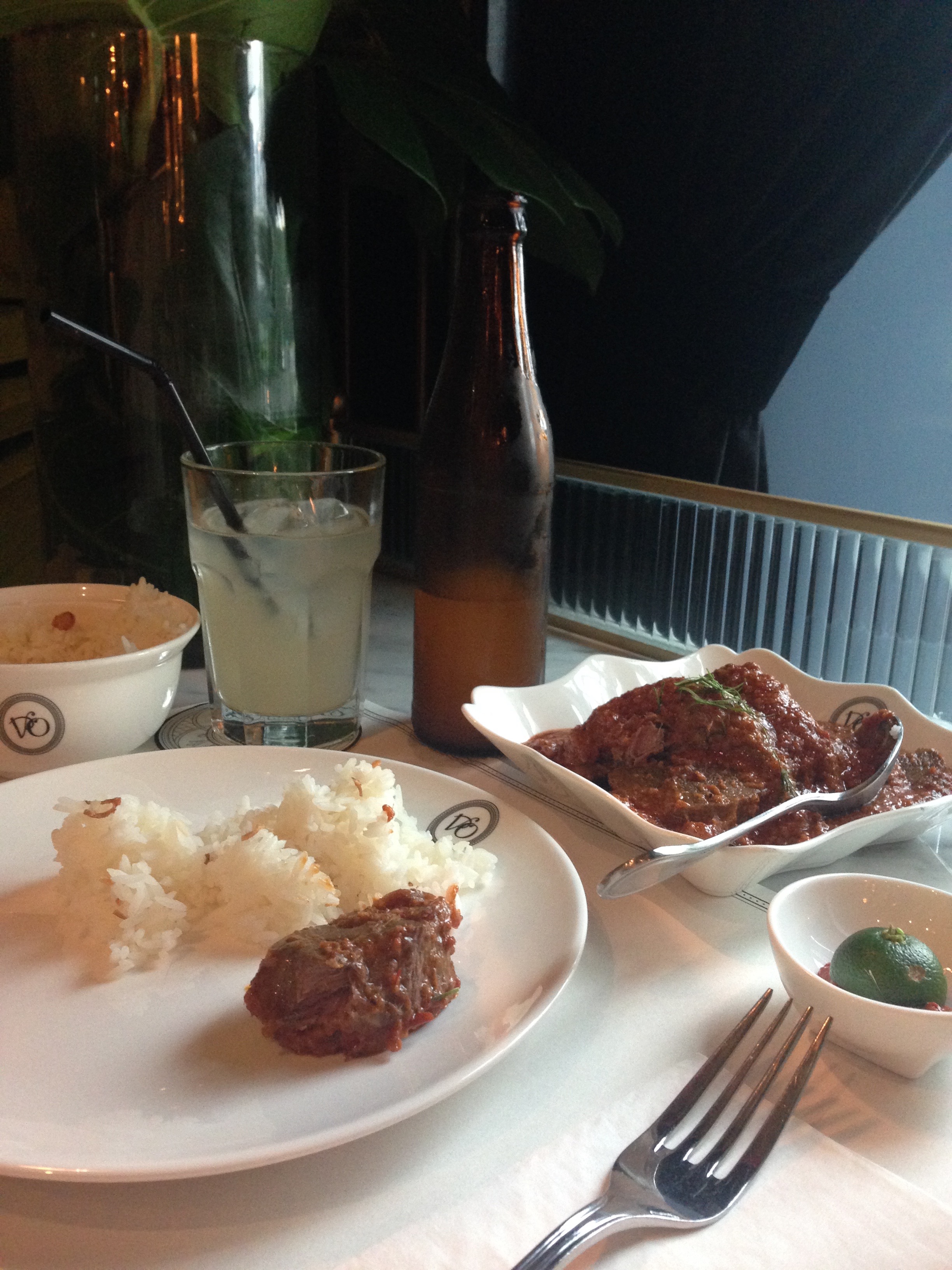
National Kitchen by Violet Oon, at the National Museum of Singapore. Photo: N. Pearson
Although there are many famous Nyonya restaurants, the best places to find Nyonya food remain inside Baba Nyonya homes. I’m privileged to be invited to Carol SelvaRajah’s home in Sydney, and as I sit down to partake of the Chinese New Year meal she has prepared, every delicious mouthful reminds me of the unique historical circumstances that gave rise to Nyonya cuisine.

Carol SelvaRajah at her home in Sydney. Photo: S. Rogers
***
Sheridan Rogers is a food and travel writer, with a popular blog. See here for her extended interview with Carol SelvaRajah.
If you are in Malacca, be sure to check out the Baba & Nyonya Heritage Museum. In Penang, you can visit the Pinang Peranakan Mansion, while Singapore is host to the marvellous Peranakan Museum.
 Facebook
Facebook  Twitter
Twitter  Soundcloud
Soundcloud  Youtube
Youtube  Rss
Rss 
